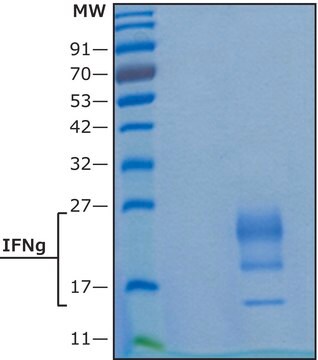SBR00027
Lipopolysaccharides from Akkermansia muciniphila
Purified by phenol extraction
About This Item
Productos recomendados
biological source
(Akkermansia muciniphila)
Quality Level
form
lyophilized powder
color
white to faint yellow
solubility
water: 1 mg/mL, faintly hazy to hazy, colorless to light yellow
storage temp.
2-8°C
General description
Application
- to impair barrier functions of Caco-2 cell monolayers tight junction
- cocultured along with A. muciniphila to study its effects on the NLR family pyrin domain containing 3 (NLRP3) expressions in Raw264.7 cells
- to activate HepG2 cells as an endotoxin together with palmitic acid (PA)
Biochem/physiol Actions
A. muciniphila degrades mucus and utilizes it as a carbon/nitrogen source. Consequently, the host produces additional mucus while the bacterium produces oligosaccharides and Short Chain Fatty Acids (SCFAs) that can be utilized by the host and trigger the immune system. An additional protective effect of the SCFA is stimulation of mucus-associated microbiota growth, that serves as a barrier against penetration of pathogens to intestinal cells.,
A. muciniphila was crowned as the next-generation beneficial microbe. Several reports have indicated that A. muciniphila affects glucose metabolism, lipid metabolism, and intestinal immunity. In addition, decreasing levels of A. muciniphila are related to the development of some diseases such as metabolic disorders and inflammatory diseases (obesity, type 2 diabetes, inflammatory bowel disease (IBD), autism and atopy. Weir et al. found a correlation between low level of A. muciniphila and colorectal cancer. Shigemetzu Y et al. found that A. muciniphila acts as a regulator of the response to PD-1 blockade which is used for anti-cancer immunotherapy. A. muciniphila induce dendritic cells to secrete IL-12, that is a critical component of the anti-cancer effect of PD-1 blockade.
LPSs from A. muciniphila stimulate NF-κB dependent secreted embryonic cell alkaline phosphatase (SEAP) production via TLR4. In addition, it induces IL-8, IL-6 and minimal amounts of IL-10 and TNF-α in peripheral blood mononuclear cells (PBMCs). A. muciniphila stimulation of IL-8 production by enterocytes was shown to be significantly (100 fold) lower than E. coli stimulation. Low proinflammatory activity keep the mucosa-associated immune system alerted at an appropriate level for generation of mucosal homeostasis.
Other Notes
signalword
Danger
hcodes
pcodes
Hazard Classifications
Acute Tox. 2 Oral
Storage Class
6.1A - Combustible acute toxic Cat. 1 and 2 / very toxic hazardous materials
wgk_germany
WGK 3
flash_point_f
Not applicable
flash_point_c
Not applicable
Elija entre una de las versiones más recientes:
Certificados de análisis (COA)
Lo sentimos, en este momento no disponemos de COAs para este producto en línea.
Si necesita más asistencia, póngase en contacto con Atención al cliente
¿Ya tiene este producto?
Encuentre la documentación para los productos que ha comprado recientemente en la Biblioteca de documentos.
Nuestro equipo de científicos tiene experiencia en todas las áreas de investigación: Ciencias de la vida, Ciencia de los materiales, Síntesis química, Cromatografía, Analítica y muchas otras.
Póngase en contacto con el Servicio técnico
